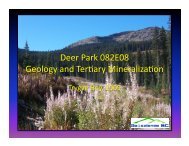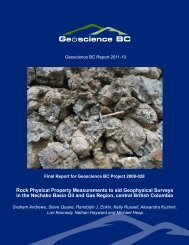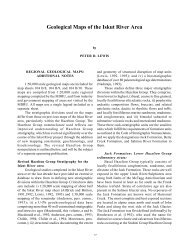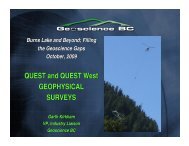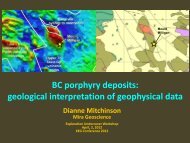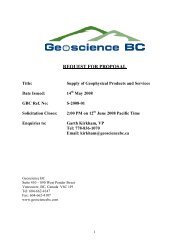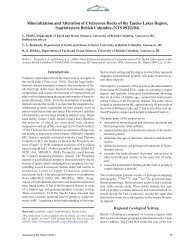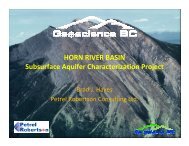Final Report - Geoscience BC
Final Report - Geoscience BC
Final Report - Geoscience BC
You also want an ePaper? Increase the reach of your titles
YUMPU automatically turns print PDFs into web optimized ePapers that Google loves.
c. Are there any relationships between susceptibility and mineralogy? Can susceptibilityact as a proxy for mineral abundance?d. Findings: Rock types have bimodal distribution of magnetic susceptibility. There is anabsence of systematic patterns (Figures 6 – 7).Step 7 – Examine the variation of magnetic susceptibility in borehole logs. They found that thehighest magnetic susceptibilities are with magnetite associated with potassic altered andesiteadjacent to the monzonite intrusion. Unaltered andesites have low susceptibility. Potassicalteration in the monzonite has moderate susceptibility related to biotite and minor magnetite(Figure 8).Step 8 – To examine the spatial relationships of magnetic susceptibility the physical propertiesare incorporated into inversion models. Modelling is done in three stages: 1. construction of asynthetic model, 2. Construction of a constrained inversion and 3. Interpretation of theinversions.a. The synthetic model. The exercises by Dianne Mitchinson illustrated how syntheticmodels can be used to show expectations of detectability as target contrast, size and depthis changed. A series of synthetic models were constructed.i. The mineralized stock has magnetic susceptibility (ms) of 32.3 x 10 -3 SI comparedto a background of 0.68 x 10 -3 SI (Figure 11).ii. Forward modeling of the distribution of ms data results in an annular geometry. Themodel uses a mesh of 2,525 m x 2,325 m with cell sizes 25 m on each side (Figure11).iii. An unconstrained synthetic model inversion generates a cone of anomalous ms thatapproximates the location of the intrusive stock. Higher ms values are at the top ofthe model and lower values at the bottom. Models indicate ms values similar towhat was measured in boreholes (Figure 12).iv. Experimentation with reduced contrast, smaller targets and burial at 150 m illustratethat detection would be more difficult. At depth a similar target could be detectedbut the target would be smoother with less definition. Targets of small size could11





